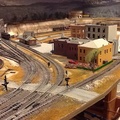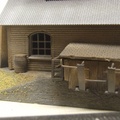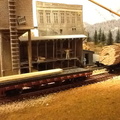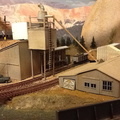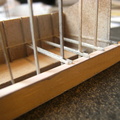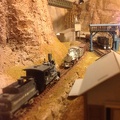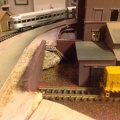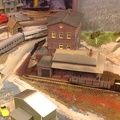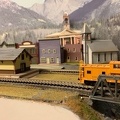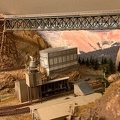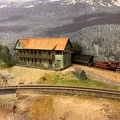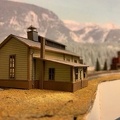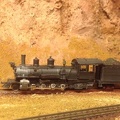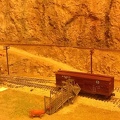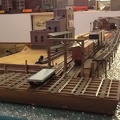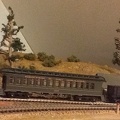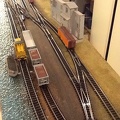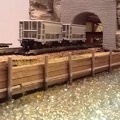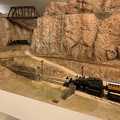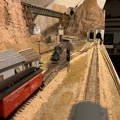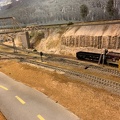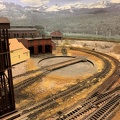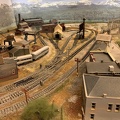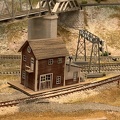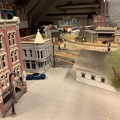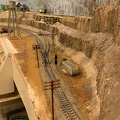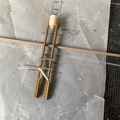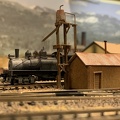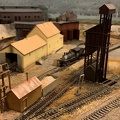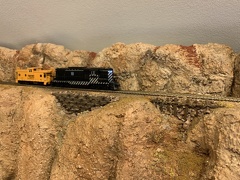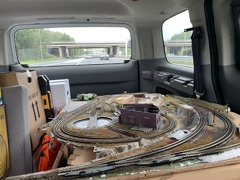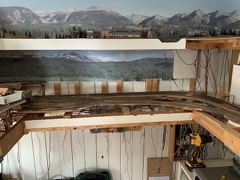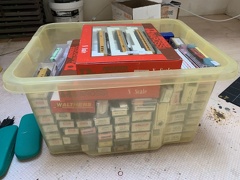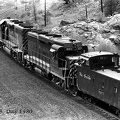The D&S NG RR
N-scale Colorado ca 1950

A versatile hobby
I’ve been modelling in N scale on and off for 30 years, starting with balsa wood and cardboard custom-building (and little pocket money to spend). In 1995 unpacked and tried a spaghetti layout after revisiting Durango for a 2nd time. Started again after moving, building the Durango to Silverton and hoping to make buildings and rolling stock look as real as possible.
You guessed it: after a visit to the area I am modelling the former route of the Denver & Rio Grande Railroad along the banks of the Animas River.
An American prototype narrow gauge mountain line starts to come alive on my N scale layout: The Durenver & Silverton Narrow Gauge Railroad (get it? Durango + Denver).
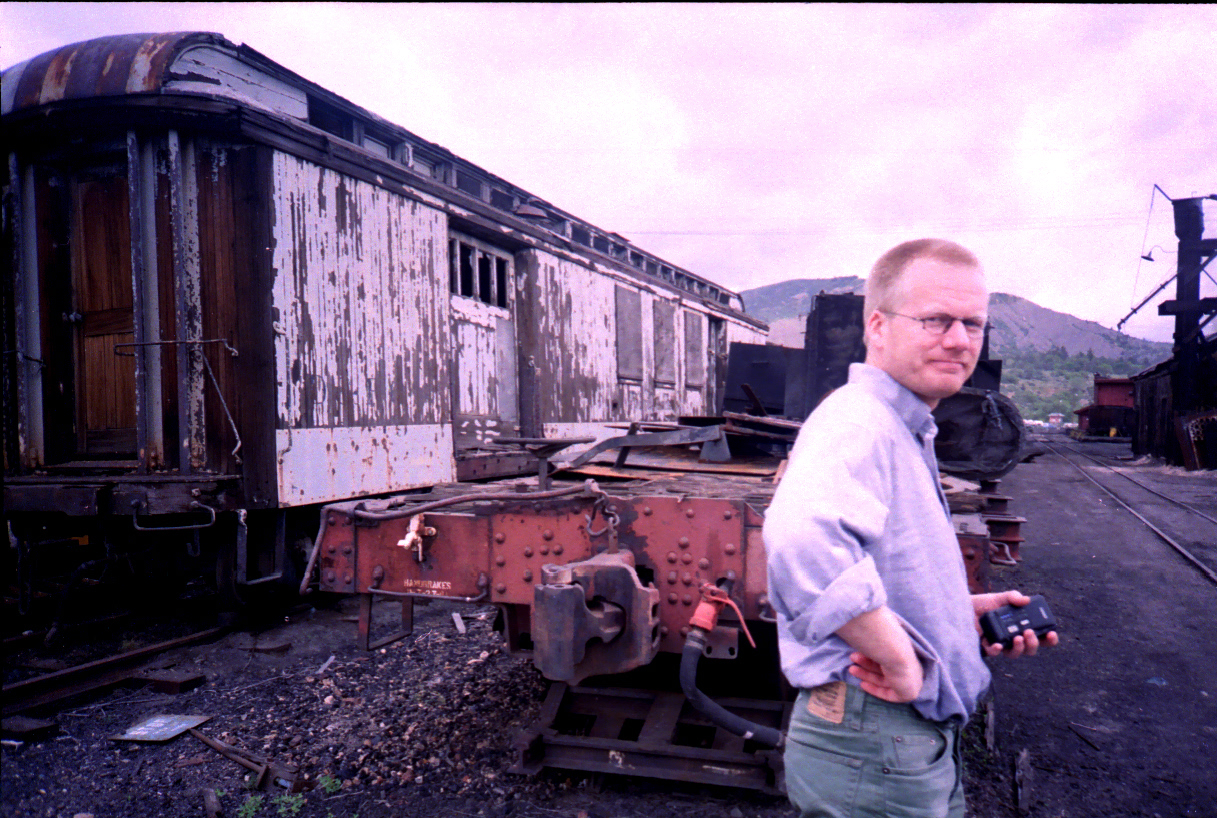
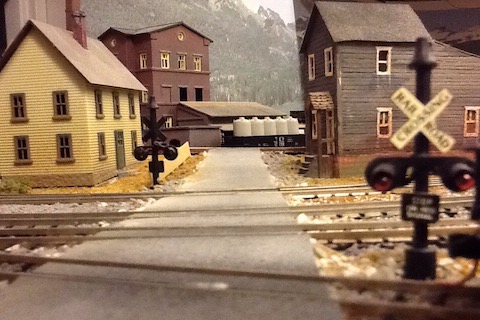
Building the D&S layout
 <a href="/assets/img/trains2/129-2997_IMG.jpg" class="image-ref" data-sub-html="D&SNG bouw niveau 1 Durango aug - sept 2003 © 1995-2024-2025 EJ Broerse CC-BY-NC-SA 4.0" data-date="dt.strftime("%Y-%m-%d") dt.strftime("%k:%M")" >
<a href="/assets/img/trains2/129-2997_IMG.jpg" class="image-ref" data-sub-html="D&SNG bouw niveau 1 Durango aug - sept 2003 © 1995-2024-2025 EJ Broerse CC-BY-NC-SA 4.0" data-date="dt.strftime("%Y-%m-%d") dt.strftime("%k:%M")" >  </a>
</a> 
 <a href="/assets/img/trains2/ATH-Challenger-RG-2006.jpg" class="image-ref" data-sub-html="ATH-Challenger-RG-2006 © 1995-2024-2025 EJ Broerse CC-BY-NC-SA 4.0" data-date="dt.strftime("%Y-%m-%d") dt.strftime("%k:%M")" >
<a href="/assets/img/trains2/ATH-Challenger-RG-2006.jpg" class="image-ref" data-sub-html="ATH-Challenger-RG-2006 © 1995-2024-2025 EJ Broerse CC-BY-NC-SA 4.0" data-date="dt.strftime("%Y-%m-%d") dt.strftime("%k:%M")" >  </a>
</a> 














 <a href="/assets/img/trains2/DSRR_Panel_Background.png" class="image-ref" data-sub-html="DSRR Panel Background © 1995-2024-2025 EJ Broerse CC-BY-NC-SA 4.0" data-date="dt.strftime("%Y-%m-%d") dt.strftime("%k:%M")" >
<a href="/assets/img/trains2/DSRR_Panel_Background.png" class="image-ref" data-sub-html="DSRR Panel Background © 1995-2024-2025 EJ Broerse CC-BY-NC-SA 4.0" data-date="dt.strftime("%Y-%m-%d") dt.strftime("%k:%M")" >  </a> <a href="/assets/img/trains2/DSRR_Panel_Screen.png" class="image-ref" data-sub-html="DSRR Panel Screen © 1995-2024-2025 EJ Broerse CC-BY-NC-SA 4.0" data-date="dt.strftime("%Y-%m-%d") dt.strftime("%k:%M")" >
</a> <a href="/assets/img/trains2/DSRR_Panel_Screen.png" class="image-ref" data-sub-html="DSRR Panel Screen © 1995-2024-2025 EJ Broerse CC-BY-NC-SA 4.0" data-date="dt.strftime("%Y-%m-%d") dt.strftime("%k:%M")" >  </a> <a href="/assets/img/trains2/Farmington_IMG_1480.jpg" class="image-ref" data-sub-html="Farmington IMG 1480 © 1995-2024-2025 EJ Broerse CC-BY-NC-SA 4.0" data-date="dt.strftime("%Y-%m-%d") dt.strftime("%k:%M")" >
</a> <a href="/assets/img/trains2/Farmington_IMG_1480.jpg" class="image-ref" data-sub-html="Farmington IMG 1480 © 1995-2024-2025 EJ Broerse CC-BY-NC-SA 4.0" data-date="dt.strftime("%Y-%m-%d") dt.strftime("%k:%M")" >  </a>
</a> 












 <a href="/assets/img/trains2/IMG_2534_lo.jpg" class="image-ref" data-sub-html="IMG 2534 lo © 1995-2024-2025 EJ Broerse CC-BY-NC-SA 4.0" data-date="dt.strftime("%Y-%m-%d") dt.strftime("%k:%M")" >
<a href="/assets/img/trains2/IMG_2534_lo.jpg" class="image-ref" data-sub-html="IMG 2534 lo © 1995-2024-2025 EJ Broerse CC-BY-NC-SA 4.0" data-date="dt.strftime("%Y-%m-%d") dt.strftime("%k:%M")" >  </a> <a href="/assets/img/trains2/IMG_2537_lo.jpg" class="image-ref" data-sub-html="IMG 2537 lo © 1995-2024-2025 EJ Broerse CC-BY-NC-SA 4.0" data-date="dt.strftime("%Y-%m-%d") dt.strftime("%k:%M")" >
</a> <a href="/assets/img/trains2/IMG_2537_lo.jpg" class="image-ref" data-sub-html="IMG 2537 lo © 1995-2024-2025 EJ Broerse CC-BY-NC-SA 4.0" data-date="dt.strftime("%Y-%m-%d") dt.strftime("%k:%M")" >  </a>
</a> 











 <a href="/assets/img/trains2/Img003.jpg" class="image-ref" data-sub-html="Img003 © 1995-2024-2025 EJ Broerse CC-BY-NC-SA 4.0" data-date="dt.strftime("%Y-%m-%d") dt.strftime("%k:%M")" >
<a href="/assets/img/trains2/Img003.jpg" class="image-ref" data-sub-html="Img003 © 1995-2024-2025 EJ Broerse CC-BY-NC-SA 4.0" data-date="dt.strftime("%Y-%m-%d") dt.strftime("%k:%M")" >  </a> <a href="/assets/img/trains2/K27_image1.jpg" class="image-ref" data-sub-html="K27 image1 © 1995-2024-2025 EJ Broerse CC-BY-NC-SA 4.0" data-date="dt.strftime("%Y-%m-%d") dt.strftime("%k:%M")" >
</a> <a href="/assets/img/trains2/K27_image1.jpg" class="image-ref" data-sub-html="K27 image1 © 1995-2024-2025 EJ Broerse CC-BY-NC-SA 4.0" data-date="dt.strftime("%Y-%m-%d") dt.strftime("%k:%M")" >  </a>
</a>  <a href="/assets/img/trains2/RioGrandeVol2.jpg" class="image-ref" data-sub-html="RioGrandeVol2 © 1995-2024-2025 EJ Broerse CC-BY-NC-SA 4.0" data-date="dt.strftime("%Y-%m-%d") dt.strftime("%k:%M")" >
<a href="/assets/img/trains2/RioGrandeVol2.jpg" class="image-ref" data-sub-html="RioGrandeVol2 © 1995-2024-2025 EJ Broerse CC-BY-NC-SA 4.0" data-date="dt.strftime("%Y-%m-%d") dt.strftime("%k:%M")" >  </a> <a href="/assets/img/trains2/RioGrande_H-15.gif" class="image-ref" data-sub-html="RioGrande H-15 © 1995-2024-2025 EJ Broerse CC-BY-NC-SA 4.0" data-date="dt.strftime("%Y-%m-%d") dt.strftime("%k:%M")" >
</a> <a href="/assets/img/trains2/RioGrande_H-15.gif" class="image-ref" data-sub-html="RioGrande H-15 © 1995-2024-2025 EJ Broerse CC-BY-NC-SA 4.0" data-date="dt.strftime("%Y-%m-%d") dt.strftime("%k:%M")" >  </a> <a href="/assets/img/trains2/S2400016-kl.jpg" class="image-ref" data-sub-html="S2400016-kl © 1995-2024-2025 EJ Broerse CC-BY-NC-SA 4.0" data-date="dt.strftime("%Y-%m-%d") dt.strftime("%k:%M")" >
</a> <a href="/assets/img/trains2/S2400016-kl.jpg" class="image-ref" data-sub-html="S2400016-kl © 1995-2024-2025 EJ Broerse CC-BY-NC-SA 4.0" data-date="dt.strftime("%Y-%m-%d") dt.strftime("%k:%M")" >  </a> <a href="/assets/img/trains2/S2400212-kl.jpg" class="image-ref" data-sub-html="S2400212-kl © 1995-2024-2025 EJ Broerse CC-BY-NC-SA 4.0" data-date="dt.strftime("%Y-%m-%d") dt.strftime("%k:%M")" >
</a> <a href="/assets/img/trains2/S2400212-kl.jpg" class="image-ref" data-sub-html="S2400212-kl © 1995-2024-2025 EJ Broerse CC-BY-NC-SA 4.0" data-date="dt.strftime("%Y-%m-%d") dt.strftime("%k:%M")" >  </a>
</a>  <a href="/assets/img/trains2/Smelter_1892_021528pu_small.jpg" class="image-ref" data-sub-html="Smelter 1892 021528pu small © 1995-2024-2025 EJ Broerse CC-BY-NC-SA 4.0" data-date="dt.strftime("%Y-%m-%d") dt.strftime("%k:%M")" >
<a href="/assets/img/trains2/Smelter_1892_021528pu_small.jpg" class="image-ref" data-sub-html="Smelter 1892 021528pu small © 1995-2024-2025 EJ Broerse CC-BY-NC-SA 4.0" data-date="dt.strftime("%Y-%m-%d") dt.strftime("%k:%M")" >  </a>
</a>  <a href="/assets/img/trains2/a2y012.jpg" class="image-ref" data-sub-html="Silverton © 1995-2024-2025 EJ Broerse CC-BY-NC-SA 4.0" data-date="dt.strftime("%Y-%m-%d") dt.strftime("%k:%M")" >
<a href="/assets/img/trains2/a2y012.jpg" class="image-ref" data-sub-html="Silverton © 1995-2024-2025 EJ Broerse CC-BY-NC-SA 4.0" data-date="dt.strftime("%Y-%m-%d") dt.strftime("%k:%M")" >  </a> <a href="/assets/img/trains2/a2y013.jpg" class="image-ref" data-sub-html="Depot Silverton. CO USA reis 1995 (South West) 14 mei - 12 juni 1995 © 1995-2024-2025 EJ Broerse CC-BY-NC-SA 4.0" data-date="dt.strftime("%Y-%m-%d") dt.strftime("%k:%M")" >
</a> <a href="/assets/img/trains2/a2y013.jpg" class="image-ref" data-sub-html="Depot Silverton. CO USA reis 1995 (South West) 14 mei - 12 juni 1995 © 1995-2024-2025 EJ Broerse CC-BY-NC-SA 4.0" data-date="dt.strftime("%Y-%m-%d") dt.strftime("%k:%M")" >  </a> <a href="/assets/img/trains2/a2y016.jpg" class="image-ref" data-sub-html="Egbert tijdens rondleiding Durango Yard. CO USA reis 1995 (South West) 14 mei - 12 juni 1995 © 1995-2024-2025 EJ Broerse CC-BY-NC-SA 4.0" data-date="dt.strftime("%Y-%m-%d") dt.strftime("%k:%M")" >
</a> <a href="/assets/img/trains2/a2y016.jpg" class="image-ref" data-sub-html="Egbert tijdens rondleiding Durango Yard. CO USA reis 1995 (South West) 14 mei - 12 juni 1995 © 1995-2024-2025 EJ Broerse CC-BY-NC-SA 4.0" data-date="dt.strftime("%Y-%m-%d") dt.strftime("%k:%M")" >  </a> <a href="/assets/img/trains2/baan-ruwbouw.jpg" class="image-ref" data-sub-html="baan-ruwbouw © 1995-2024-2025 EJ Broerse CC-BY-NC-SA 4.0" data-date="dt.strftime("%Y-%m-%d") dt.strftime("%k:%M")" >
</a> <a href="/assets/img/trains2/baan-ruwbouw.jpg" class="image-ref" data-sub-html="baan-ruwbouw © 1995-2024-2025 EJ Broerse CC-BY-NC-SA 4.0" data-date="dt.strftime("%Y-%m-%d") dt.strftime("%k:%M")" >  </a> <a href="/assets/img/trains2/baan-ruwboven.jpg" class="image-ref" data-sub-html="baan-ruwboven © 1995-2024-2025 EJ Broerse CC-BY-NC-SA 4.0" data-date="dt.strftime("%Y-%m-%d") dt.strftime("%k:%M")" >
</a> <a href="/assets/img/trains2/baan-ruwboven.jpg" class="image-ref" data-sub-html="baan-ruwboven © 1995-2024-2025 EJ Broerse CC-BY-NC-SA 4.0" data-date="dt.strftime("%Y-%m-%d") dt.strftime("%k:%M")" >  </a> <a href="/assets/img/trains2/baan-ruwrechts.jpg" class="image-ref" data-sub-html="baan-ruwrechts © 1995-2024-2025 EJ Broerse CC-BY-NC-SA 4.0" data-date="dt.strftime("%Y-%m-%d") dt.strftime("%k:%M")" >
</a> <a href="/assets/img/trains2/baan-ruwrechts.jpg" class="image-ref" data-sub-html="baan-ruwrechts © 1995-2024-2025 EJ Broerse CC-BY-NC-SA 4.0" data-date="dt.strftime("%Y-%m-%d") dt.strftime("%k:%M")" >  </a> <a href="/assets/img/trains2/baan-silvertXruw.jpg" class="image-ref" data-sub-html="baan-silvertXruw © 1995-2024-2025 EJ Broerse CC-BY-NC-SA 4.0" data-date="dt.strftime("%Y-%m-%d") dt.strftime("%k:%M")" >
</a> <a href="/assets/img/trains2/baan-silvertXruw.jpg" class="image-ref" data-sub-html="baan-silvertXruw © 1995-2024-2025 EJ Broerse CC-BY-NC-SA 4.0" data-date="dt.strftime("%Y-%m-%d") dt.strftime("%k:%M")" >  </a> <a href="/assets/img/trains2/baan-silvertwyeruw.jpg" class="image-ref" data-sub-html="baan-silvertwyeruw © 1995-2024-2025 EJ Broerse CC-BY-NC-SA 4.0" data-date="dt.strftime("%Y-%m-%d") dt.strftime("%k:%M")" >
</a> <a href="/assets/img/trains2/baan-silvertwyeruw.jpg" class="image-ref" data-sub-html="baan-silvertwyeruw © 1995-2024-2025 EJ Broerse CC-BY-NC-SA 4.0" data-date="dt.strftime("%Y-%m-%d") dt.strftime("%k:%M")" >  </a> <a href="/assets/img/trains2/baan_paneelruw.jpg" class="image-ref" data-sub-html="baan paneelruw © 1995-2024-2025 EJ Broerse CC-BY-NC-SA 4.0" data-date="dt.strftime("%Y-%m-%d") dt.strftime("%k:%M")" >
</a> <a href="/assets/img/trains2/baan_paneelruw.jpg" class="image-ref" data-sub-html="baan paneelruw © 1995-2024-2025 EJ Broerse CC-BY-NC-SA 4.0" data-date="dt.strftime("%Y-%m-%d") dt.strftime("%k:%M")" >  </a> <a href="/assets/img/trains2/d_and_s/LocoIO_Inverter_PCB.png" class="image-ref" data-sub-html="LocoIO Inverter PCB © 1995-2024-2025 EJ Broerse CC-BY-NC-SA 4.0" data-date="dt.strftime("%Y-%m-%d") dt.strftime("%k:%M")" >
</a> <a href="/assets/img/trains2/d_and_s/LocoIO_Inverter_PCB.png" class="image-ref" data-sub-html="LocoIO Inverter PCB © 1995-2024-2025 EJ Broerse CC-BY-NC-SA 4.0" data-date="dt.strftime("%Y-%m-%d") dt.strftime("%k:%M")" >  </a>
</a>  <a href="/assets/img/trains2/d_and_s/LocoIO_inverter_diagram.png" class="image-ref" data-sub-html="LocoIO inverter diagram © 1995-2024-2025 EJ Broerse CC-BY-NC-SA 4.0" data-date="dt.strftime("%Y-%m-%d") dt.strftime("%k:%M")" >
<a href="/assets/img/trains2/d_and_s/LocoIO_inverter_diagram.png" class="image-ref" data-sub-html="LocoIO inverter diagram © 1995-2024-2025 EJ Broerse CC-BY-NC-SA 4.0" data-date="dt.strftime("%Y-%m-%d") dt.strftime("%k:%M")" >  </a>
</a>  <a href="/assets/img/trains2/d_and_s/Plan_DSRR_2024.png" class="image-ref" data-sub-html="Plan DSRR 2024 © 1995-2024-2025 EJ Broerse CC-BY-NC-SA 4.0" data-date="dt.strftime("%Y-%m-%d") dt.strftime("%k:%M")" >
<a href="/assets/img/trains2/d_and_s/Plan_DSRR_2024.png" class="image-ref" data-sub-html="Plan DSRR 2024 © 1995-2024-2025 EJ Broerse CC-BY-NC-SA 4.0" data-date="dt.strftime("%Y-%m-%d") dt.strftime("%k:%M")" >  </a>
</a> 



 <a href="/assets/img/trains2/dcclogo.gif" class="image-ref" data-sub-html="dcclogo © 1995-2024-2025 EJ Broerse CC-BY-NC-SA 4.0" data-date="dt.strftime("%Y-%m-%d") dt.strftime("%k:%M")" >
<a href="/assets/img/trains2/dcclogo.gif" class="image-ref" data-sub-html="dcclogo © 1995-2024-2025 EJ Broerse CC-BY-NC-SA 4.0" data-date="dt.strftime("%Y-%m-%d") dt.strftime("%k:%M")" > 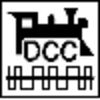 </a>
</a>  <a href="/assets/img/trains2/dsng_map.png" class="image-ref" data-sub-html="dsng map © 1995-2024-2025 EJ Broerse CC-BY-NC-SA 4.0" data-date="dt.strftime("%Y-%m-%d") dt.strftime("%k:%M")" >
<a href="/assets/img/trains2/dsng_map.png" class="image-ref" data-sub-html="dsng map © 1995-2024-2025 EJ Broerse CC-BY-NC-SA 4.0" data-date="dt.strftime("%Y-%m-%d") dt.strftime("%k:%M")" >  </a> <a href="/assets/img/trains2/jmri-le-slipedit.png" class="image-ref" data-sub-html="jmri-le-slipedit © 1995-2024-2025 EJ Broerse CC-BY-NC-SA 4.0" data-date="dt.strftime("%Y-%m-%d") dt.strftime("%k:%M")" >
</a> <a href="/assets/img/trains2/jmri-le-slipedit.png" class="image-ref" data-sub-html="jmri-le-slipedit © 1995-2024-2025 EJ Broerse CC-BY-NC-SA 4.0" data-date="dt.strftime("%Y-%m-%d") dt.strftime("%k:%M")" >  </a> <a href="/assets/img/trains2/jmri/cpe-slip-c.png" class="image-ref" data-sub-html="cpe-slip-c © 1995-2024-2025 EJ Broerse CC-BY-NC-SA 4.0" data-date="dt.strftime("%Y-%m-%d") dt.strftime("%k:%M")" >
</a> <a href="/assets/img/trains2/jmri/cpe-slip-c.png" class="image-ref" data-sub-html="cpe-slip-c © 1995-2024-2025 EJ Broerse CC-BY-NC-SA 4.0" data-date="dt.strftime("%Y-%m-%d") dt.strftime("%k:%M")" >  </a> <a href="/assets/img/trains2/jmri/cpe-slip-t.png" class="image-ref" data-sub-html="cpe-slip-t © 1995-2024-2025 EJ Broerse CC-BY-NC-SA 4.0" data-date="dt.strftime("%Y-%m-%d") dt.strftime("%k:%M")" >
</a> <a href="/assets/img/trains2/jmri/cpe-slip-t.png" class="image-ref" data-sub-html="cpe-slip-t © 1995-2024-2025 EJ Broerse CC-BY-NC-SA 4.0" data-date="dt.strftime("%Y-%m-%d") dt.strftime("%k:%M")" >  </a> <a href="/assets/img/trains2/jmri/jmri-le-slipedit-en.png" class="image-ref" data-sub-html="jmri-le-slipedit-en © 1995-2024-2025 EJ Broerse CC-BY-NC-SA 4.0" data-date="dt.strftime("%Y-%m-%d") dt.strftime("%k:%M")" >
</a> <a href="/assets/img/trains2/jmri/jmri-le-slipedit-en.png" class="image-ref" data-sub-html="jmri-le-slipedit-en © 1995-2024-2025 EJ Broerse CC-BY-NC-SA 4.0" data-date="dt.strftime("%Y-%m-%d") dt.strftime("%k:%M")" >  </a> <a href="/assets/img/trains2/jmri/jmri-le-slipedit-nl.png" class="image-ref" data-sub-html="jmri-le-slipedit-nl © 1995-2024-2025 EJ Broerse CC-BY-NC-SA 4.0" data-date="dt.strftime("%Y-%m-%d") dt.strftime("%k:%M")" >
</a> <a href="/assets/img/trains2/jmri/jmri-le-slipedit-nl.png" class="image-ref" data-sub-html="jmri-le-slipedit-nl © 1995-2024-2025 EJ Broerse CC-BY-NC-SA 4.0" data-date="dt.strftime("%Y-%m-%d") dt.strftime("%k:%M")" >  </a> <a href="/assets/img/trains2/jmri/jmri-logix-edit.png" class="image-ref" data-sub-html="jmri-logix-edit © 1995-2024-2025 EJ Broerse CC-BY-NC-SA 4.0" data-date="dt.strftime("%Y-%m-%d") dt.strftime("%k:%M")" >
</a> <a href="/assets/img/trains2/jmri/jmri-logix-edit.png" class="image-ref" data-sub-html="jmri-logix-edit © 1995-2024-2025 EJ Broerse CC-BY-NC-SA 4.0" data-date="dt.strftime("%Y-%m-%d") dt.strftime("%k:%M")" >  </a> <a href="/assets/img/trains2/jmri/slip-icon-set-en.png" class="image-ref" data-sub-html="slip-icon-set-en © 1995-2024-2025 EJ Broerse CC-BY-NC-SA 4.0" data-date="dt.strftime("%Y-%m-%d") dt.strftime("%k:%M")" >
</a> <a href="/assets/img/trains2/jmri/slip-icon-set-en.png" class="image-ref" data-sub-html="slip-icon-set-en © 1995-2024-2025 EJ Broerse CC-BY-NC-SA 4.0" data-date="dt.strftime("%Y-%m-%d") dt.strftime("%k:%M")" >  <a href="/assets/img/trains2/kalendersfeer.jpg" class="image-ref" data-sub-html="kalendersfeer © 1995-2024-2025 EJ Broerse CC-BY-NC-SA 4.0" data-date="dt.strftime("%Y-%m-%d") dt.strftime("%k:%M")" >
<a href="/assets/img/trains2/kalendersfeer.jpg" class="image-ref" data-sub-html="kalendersfeer © 1995-2024-2025 EJ Broerse CC-BY-NC-SA 4.0" data-date="dt.strftime("%Y-%m-%d") dt.strftime("%k:%M")" >  </a> <a href="/assets/img/trains2/logo-jmri.gif" class="image-ref" data-sub-html="logo-jmri © 1995-2024-2025 EJ Broerse CC-BY-NC-SA 4.0" data-date="dt.strftime("%Y-%m-%d") dt.strftime("%k:%M")" >
</a> <a href="/assets/img/trains2/logo-jmri.gif" class="image-ref" data-sub-html="logo-jmri © 1995-2024-2025 EJ Broerse CC-BY-NC-SA 4.0" data-date="dt.strftime("%Y-%m-%d") dt.strftime("%k:%M")" >  </a>
</a>  <a href="/assets/img/trains2/nx-tableau_eindhoven.jpg" class="image-ref" data-sub-html="The NX CTC machine in Eindhoven, The Netherlands Nico Spilt" data-date="dt.strftime("%Y-%m-%d") dt.strftime("%k:%M")" >
<a href="/assets/img/trains2/nx-tableau_eindhoven.jpg" class="image-ref" data-sub-html="The NX CTC machine in Eindhoven, The Netherlands Nico Spilt" data-date="dt.strftime("%Y-%m-%d") dt.strftime("%k:%M")" >  </a> <a href="/assets/img/trains2/prototype/20131030205838-28a115e5.jpg" class="image-ref" data-sub-html="Durango yard viewed from the coal tower ca. 1930. © 1995-2024-2025 EJ Broerse CC-BY-NC-SA 4.0" data-date="dt.strftime("%Y-%m-%d") dt.strftime("%k:%M")" >
</a> <a href="/assets/img/trains2/prototype/20131030205838-28a115e5.jpg" class="image-ref" data-sub-html="Durango yard viewed from the coal tower ca. 1930. © 1995-2024-2025 EJ Broerse CC-BY-NC-SA 4.0" data-date="dt.strftime("%Y-%m-%d") dt.strftime("%k:%M")" >  </a>
</a> 

 <a href="/assets/img/trains2/prototype/Rockwood-Img009.jpg" class="image-ref" data-sub-html="Rockwood-Img009 © 1995-2024-2025 EJ Broerse CC-BY-NC-SA 4.0" data-date="dt.strftime("%Y-%m-%d") dt.strftime("%k:%M")" >
<a href="/assets/img/trains2/prototype/Rockwood-Img009.jpg" class="image-ref" data-sub-html="Rockwood-Img009 © 1995-2024-2025 EJ Broerse CC-BY-NC-SA 4.0" data-date="dt.strftime("%Y-%m-%d") dt.strftime("%k:%M")" >  </a> <a href="/assets/img/trains2/rgsnumber2.jpg" class="image-ref" data-sub-html="rgsnumber2 © 1995-2024-2025 EJ Broerse CC-BY-NC-SA 4.0" data-date="dt.strftime("%Y-%m-%d") dt.strftime("%k:%M")" >
</a> <a href="/assets/img/trains2/rgsnumber2.jpg" class="image-ref" data-sub-html="rgsnumber2 © 1995-2024-2025 EJ Broerse CC-BY-NC-SA 4.0" data-date="dt.strftime("%Y-%m-%d") dt.strftime("%k:%M")" >  </a>
</a>  <a href="/assets/img/trains2/trackplan_Durango.png" class="image-ref" data-sub-html="trackplan Durango © 1995-2024-2025 EJ Broerse CC-BY-NC-SA 4.0" data-date="dt.strftime("%Y-%m-%d") dt.strftime("%k:%M")" >
<a href="/assets/img/trains2/trackplan_Durango.png" class="image-ref" data-sub-html="trackplan Durango © 1995-2024-2025 EJ Broerse CC-BY-NC-SA 4.0" data-date="dt.strftime("%Y-%m-%d") dt.strftime("%k:%M")" >  </a> <a href="/assets/img/trains2/trackplan_Durenver.png" class="image-ref" data-sub-html="trackplan Durenver © 1995-2024-2025 EJ Broerse CC-BY-NC-SA 4.0" data-date="dt.strftime("%Y-%m-%d") dt.strftime("%k:%M")" >
</a> <a href="/assets/img/trains2/trackplan_Durenver.png" class="image-ref" data-sub-html="trackplan Durenver © 1995-2024-2025 EJ Broerse CC-BY-NC-SA 4.0" data-date="dt.strftime("%Y-%m-%d") dt.strftime("%k:%M")" >  </a> <a href="/assets/img/trains2/trackplan_Newport.png" class="image-ref" data-sub-html="trackplan Newport © 1995-2024-2025 EJ Broerse CC-BY-NC-SA 4.0" data-date="dt.strftime("%Y-%m-%d") dt.strftime("%k:%M")" >
</a> <a href="/assets/img/trains2/trackplan_Newport.png" class="image-ref" data-sub-html="trackplan Newport © 1995-2024-2025 EJ Broerse CC-BY-NC-SA 4.0" data-date="dt.strftime("%Y-%m-%d") dt.strftime("%k:%M")" >  </a> <a href="/assets/img/trains2/trackplan_Rockwood.png" class="image-ref" data-sub-html="trackplan Rockwood © 1995-2024-2025 EJ Broerse CC-BY-NC-SA 4.0" data-date="dt.strftime("%Y-%m-%d") dt.strftime("%k:%M")" >
</a> <a href="/assets/img/trains2/trackplan_Rockwood.png" class="image-ref" data-sub-html="trackplan Rockwood © 1995-2024-2025 EJ Broerse CC-BY-NC-SA 4.0" data-date="dt.strftime("%Y-%m-%d") dt.strftime("%k:%M")" >  </a> <a href="/assets/img/trains2/trackplan_Silverton.png" class="image-ref" data-sub-html="trackplan Silverton © 1995-2024-2025 EJ Broerse CC-BY-NC-SA 4.0" data-date="dt.strftime("%Y-%m-%d") dt.strftime("%k:%M")" >
</a> <a href="/assets/img/trains2/trackplan_Silverton.png" class="image-ref" data-sub-html="trackplan Silverton © 1995-2024-2025 EJ Broerse CC-BY-NC-SA 4.0" data-date="dt.strftime("%Y-%m-%d") dt.strftime("%k:%M")" >  </a> <a href="/assets/img/trains2/trackplan_Thoreau.png" class="image-ref" data-sub-html="trackplan Thoreau © 1995-2024-2025 EJ Broerse CC-BY-NC-SA 4.0" data-date="dt.strftime("%Y-%m-%d") dt.strftime("%k:%M")" >
</a> <a href="/assets/img/trains2/trackplan_Thoreau.png" class="image-ref" data-sub-html="trackplan Thoreau © 1995-2024-2025 EJ Broerse CC-BY-NC-SA 4.0" data-date="dt.strftime("%Y-%m-%d") dt.strftime("%k:%M")" >  </a> <a href="/assets/img/trains2/trackplan_full.png" class="image-ref" data-sub-html="trackplan full © 1995-2024-2025 EJ Broerse CC-BY-NC-SA 4.0" data-date="dt.strftime("%Y-%m-%d") dt.strftime("%k:%M")" >
</a> <a href="/assets/img/trains2/trackplan_full.png" class="image-ref" data-sub-html="trackplan full © 1995-2024-2025 EJ Broerse CC-BY-NC-SA 4.0" data-date="dt.strftime("%Y-%m-%d") dt.strftime("%k:%M")" >  </a>
</a> More images of the layout
Modeling the D&SNG RR
After we moved house, I kept two modules from the original layout and installed them back to back suspended over a workbench. Back to basics, just like our house in fact: digital switching, signals, kept the nicest buildings and put the other stuff up for sale…
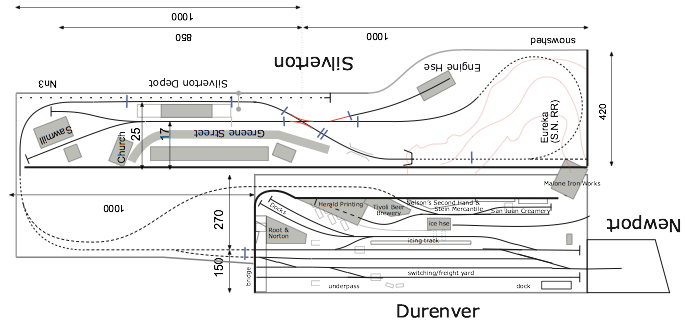
- Name
- Durenver & Silverton Narrow Gauge RR
- Theme
- Colorado Rocky Mountain mining
- Scale
- N/Nn3 Scale (1:160 9mm/6mm gauge)
- Era
- circa 1955
- Minimum Radius
- 10 in/25 cm
- Turnouts
- Atlas code 80 #6
- Mainline Run
- 20 ft/6 m = 1 scale km
- Dimensions
- 7 ft x 4 ft/2.2 m x 1.2 m island
A tour of the former layout
| Newport | Farmington | Durenver | Rockwood | Silverton |
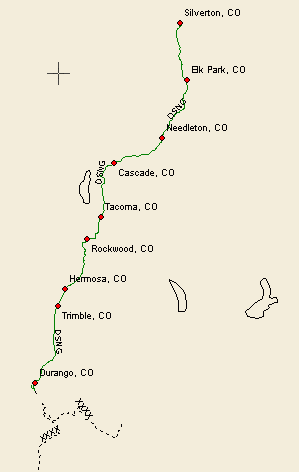
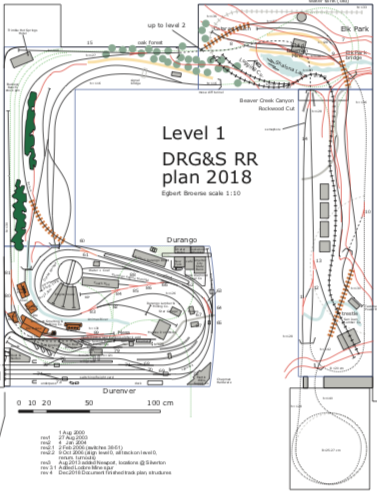
(view the complete Track Plan as a PDF).
- Name
- Durenver & Silverton Narrow Gauge RR
- Theme
- Colorado Rocky Mountain mining, logging, cattle & passenger trains, interchange with SF at Thoreau NM and D&RGW at Grand Junction CO
- Scale
- N/Nn3 Scale
- Era
- circa 1955
- Minimum Radius
- 10 in/25 cm
- Turnouts
- Atlas code 55/80 #7/#6, Peco streamline #8, Minitrix #4
- Mainline Run
- 100 ft/30 m = 4.8 scale km
- Dimensions
- 11 ft x 8 ft/3.5 m x 2.5 m around the wall
See the LDA stats below.
Until the summer of the year 2000 there wasn’t much room to spike down the tracks, but one day in 2018 the trains crossed the miniature Rockies all the way up to the town of Silverton.
Level 0: Newport, OR
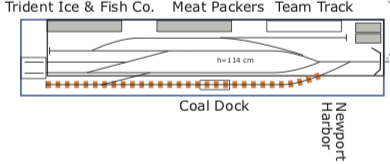
There just had to be a port with a cannery and coal dock on the layout. I found a fitting prototype along the Tacoma Sound in Oregon, where some D&S engines were sent during WWII, so the connection is clear (but the run is a lot shorter).
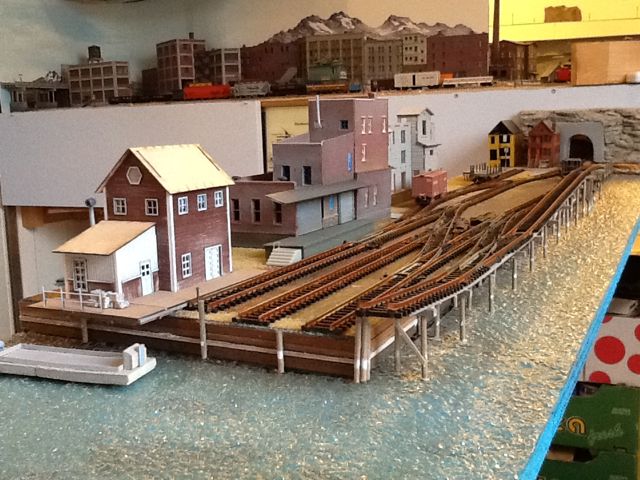
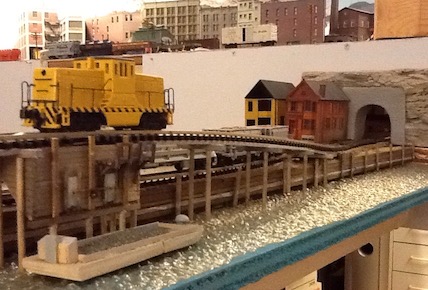
Level 0: Farmington and Thoreau, NM
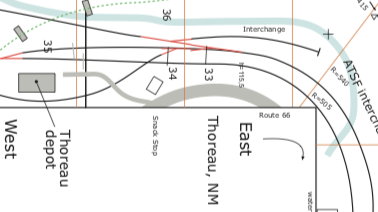
The Farmington Branch has an interchange with the Santa Fe in the desert town of Thoreau, which explains the big diesels of a Class I RR.
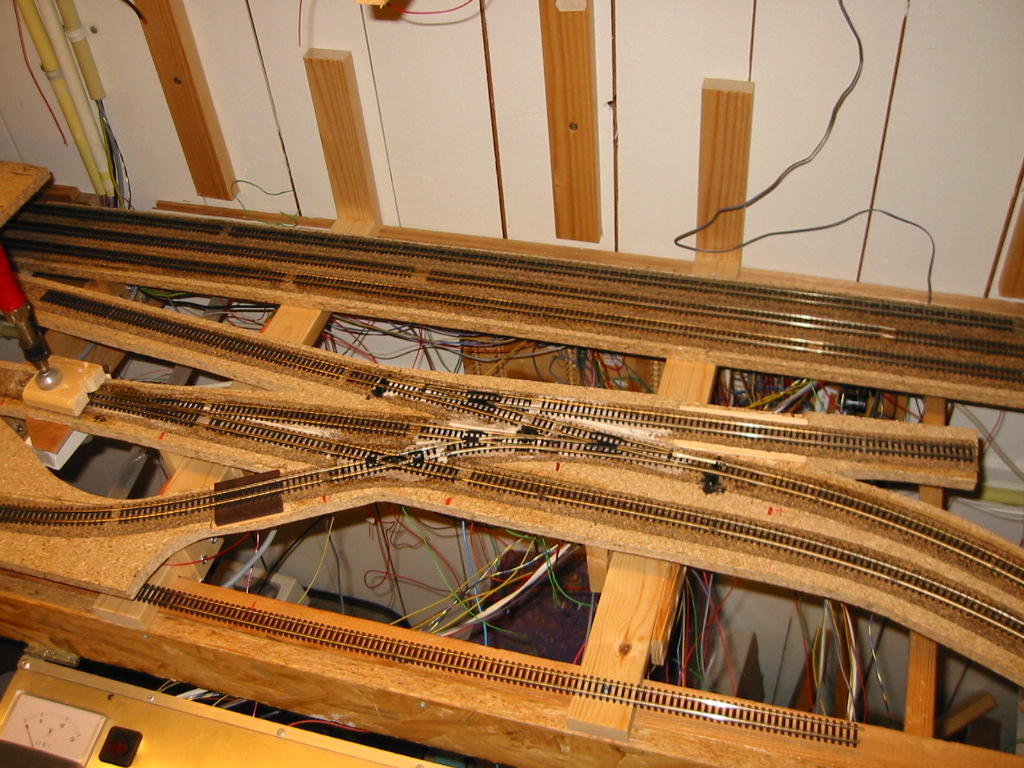
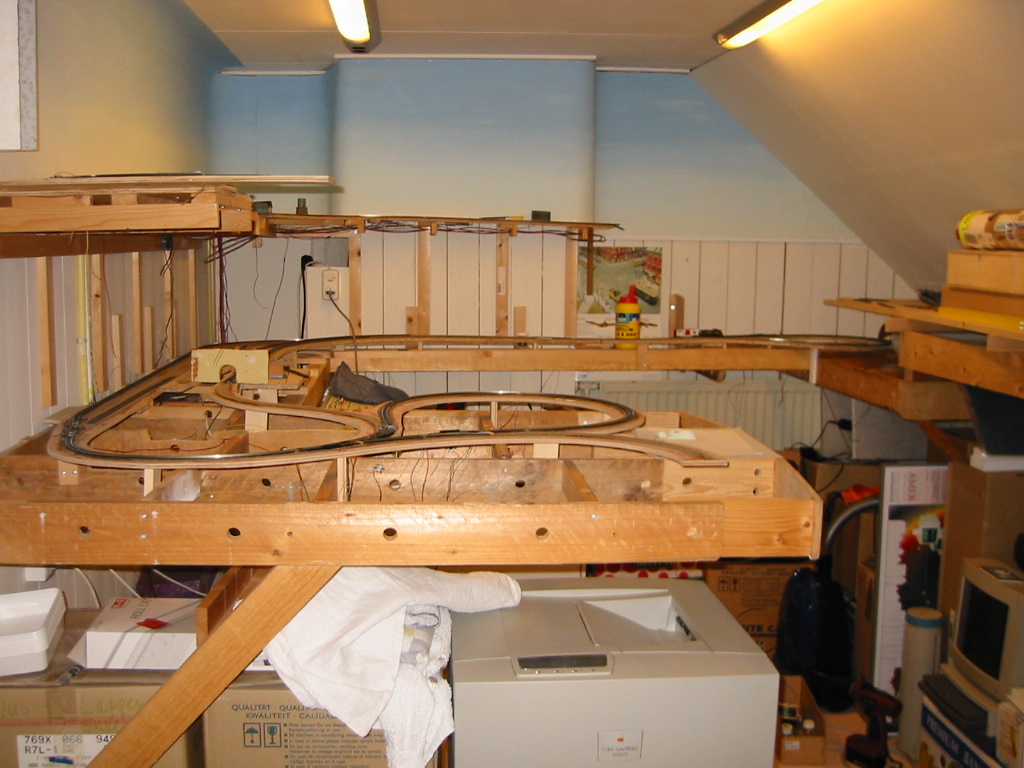
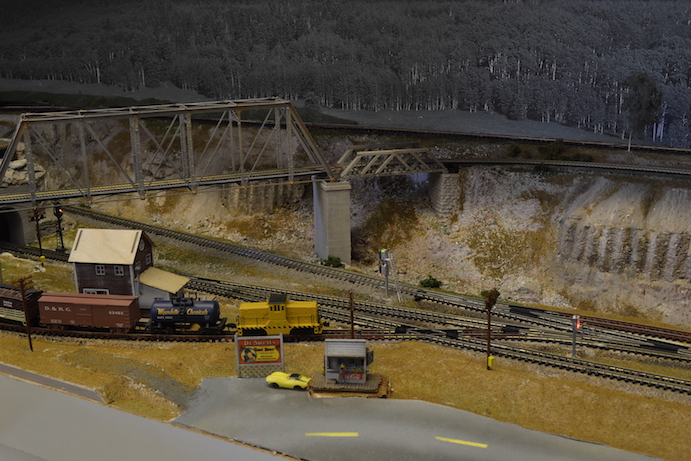
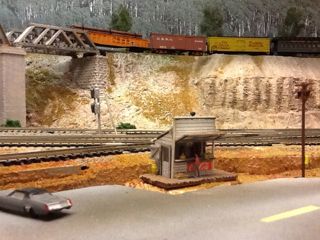
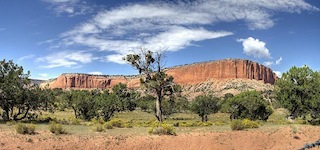
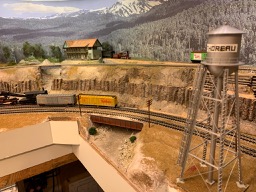
Level 1: Durenver, CO
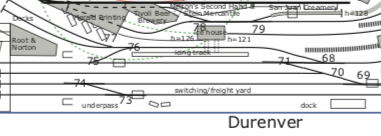
Durenver is the main town on the layout, a fictional combination of Durango town and depot located high in the Rockies with the Denver, CO dense urban warehouses next to the yard.
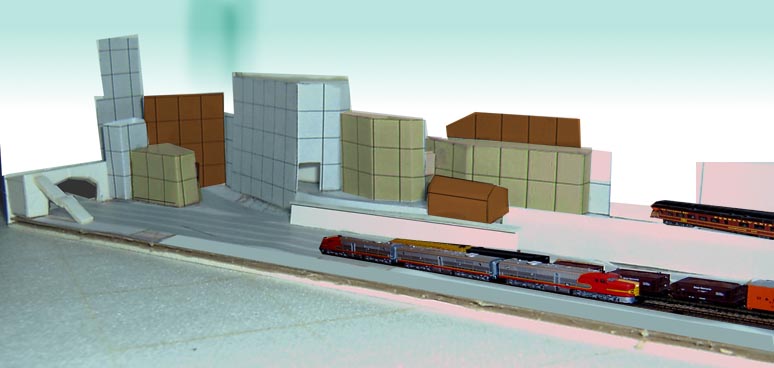
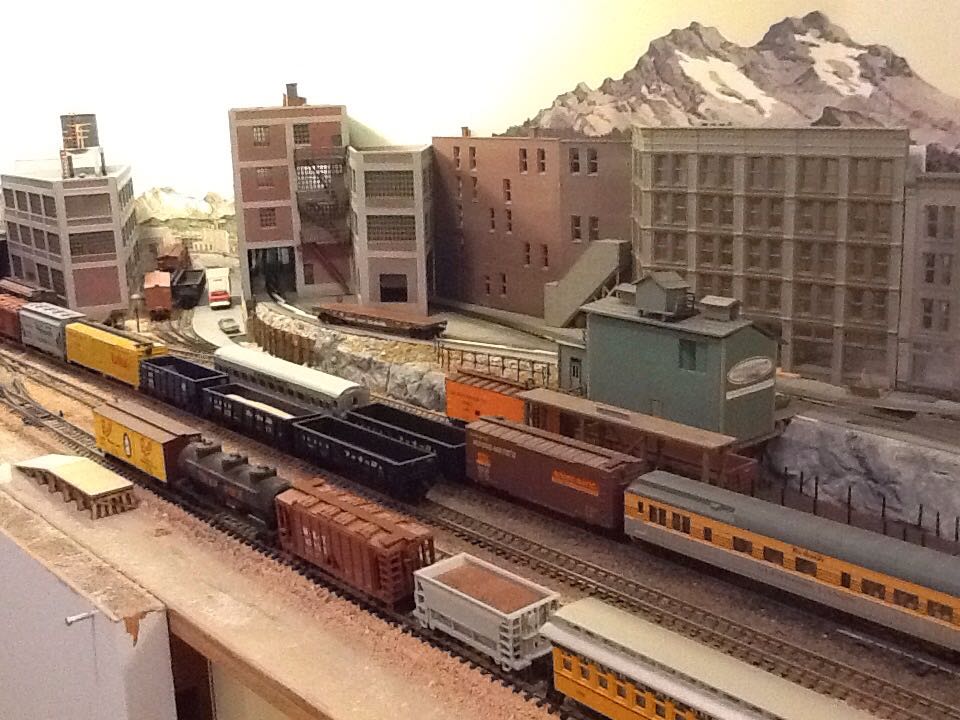
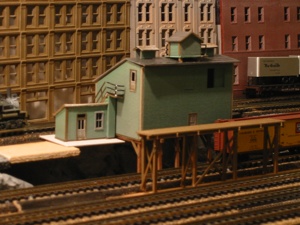
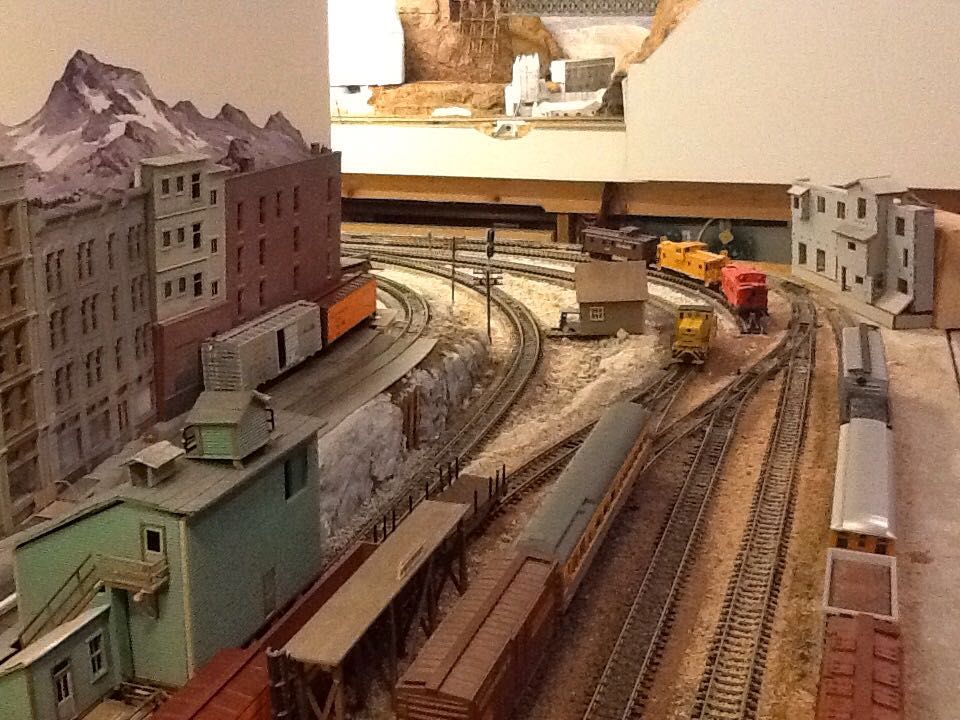
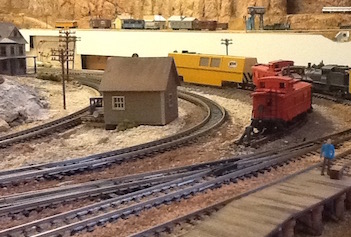
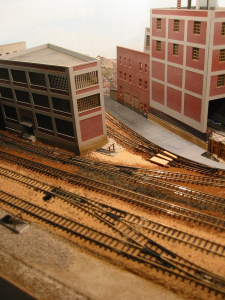
Level 1: Durango, CO D&SNG Yard
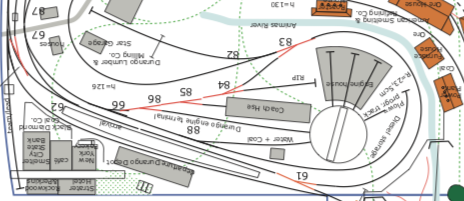
Central point on the layout is the historic depot and boom town of Durango, CO.
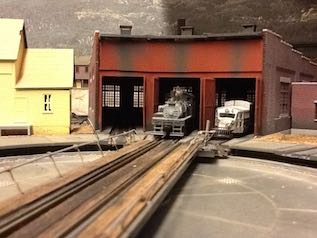
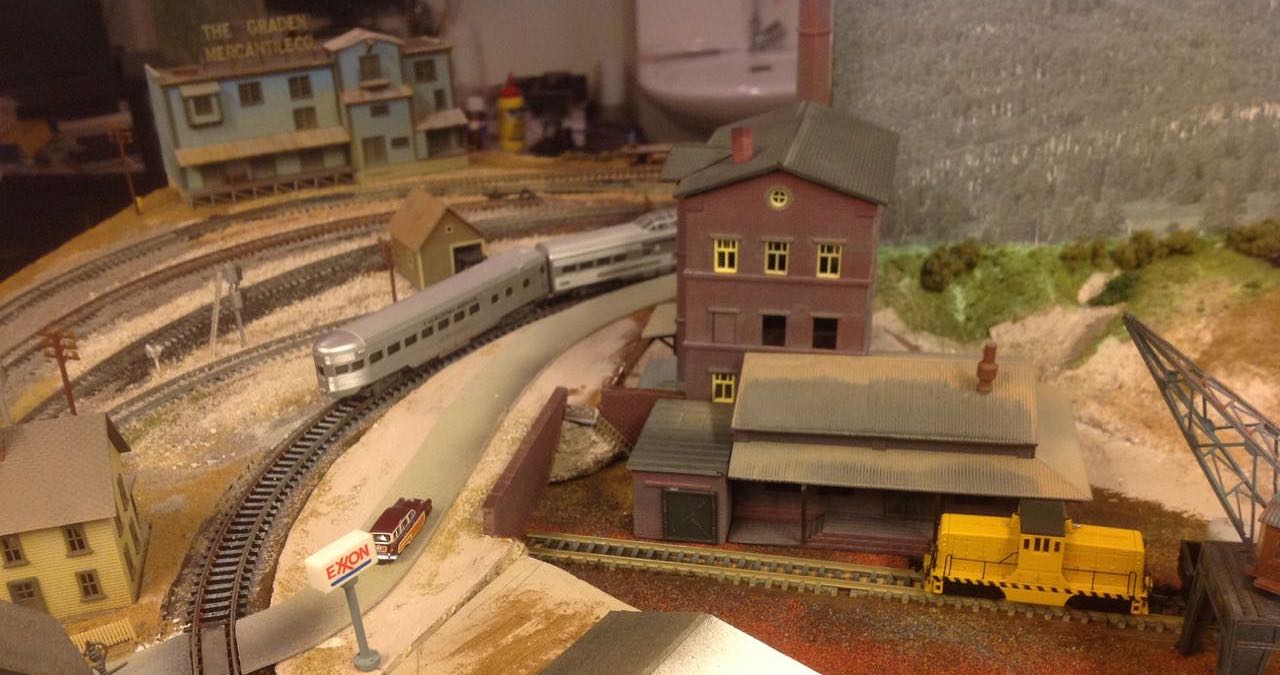
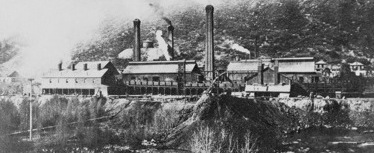
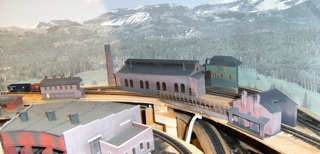
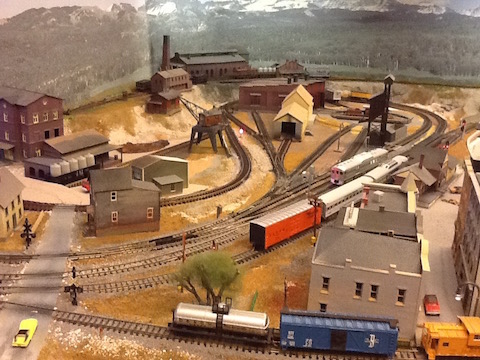
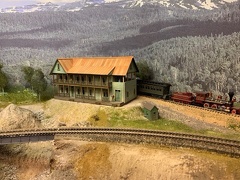
Level 2: Rockwood, CO

A small settlement halfway up near the High Line, just a couple of houses and a small depot plus lumber mill. A small steam operated narrow gauge segment brings in the logs.
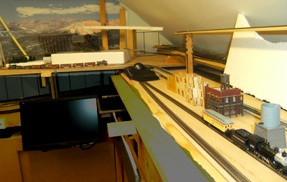
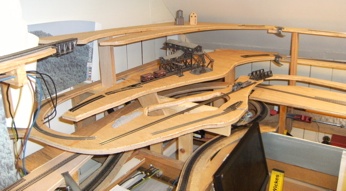
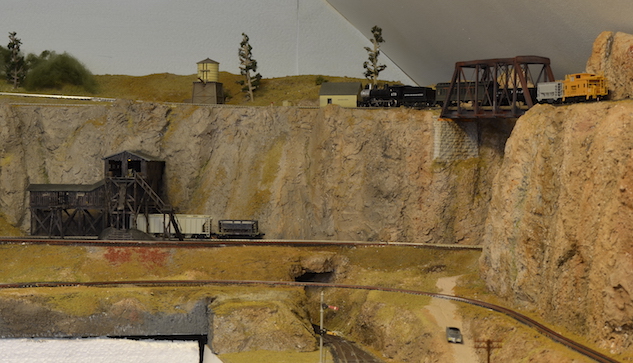
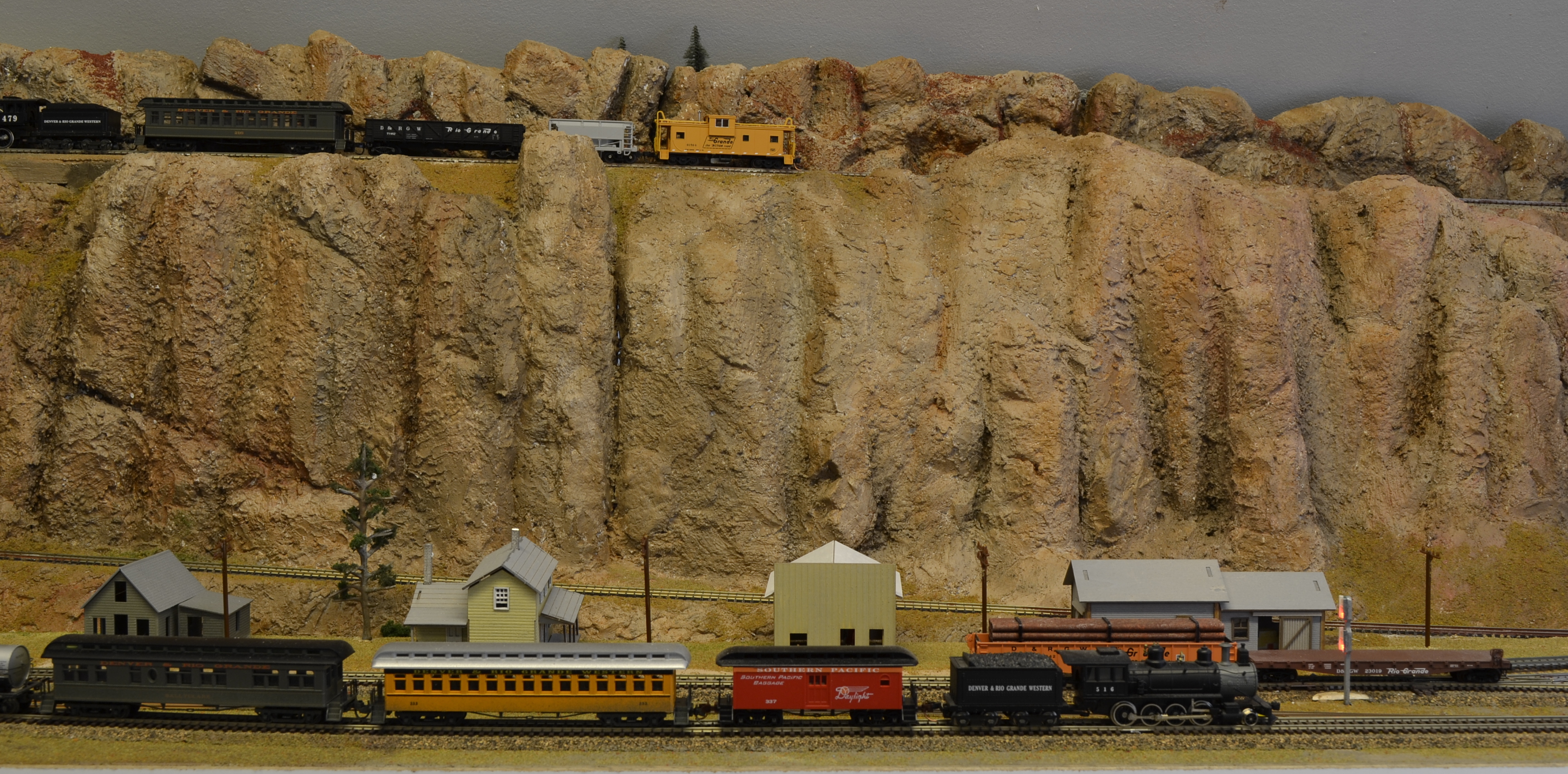
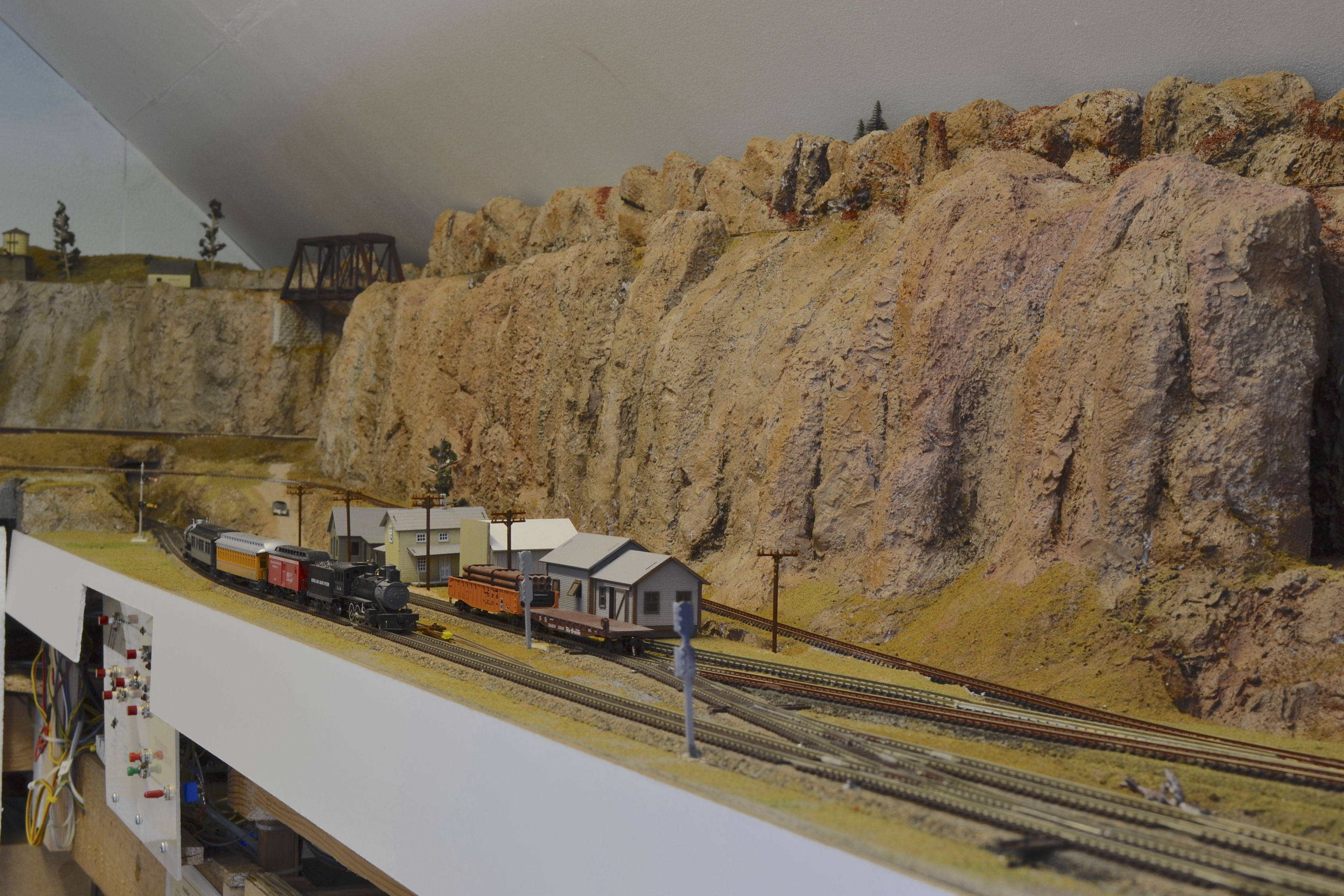
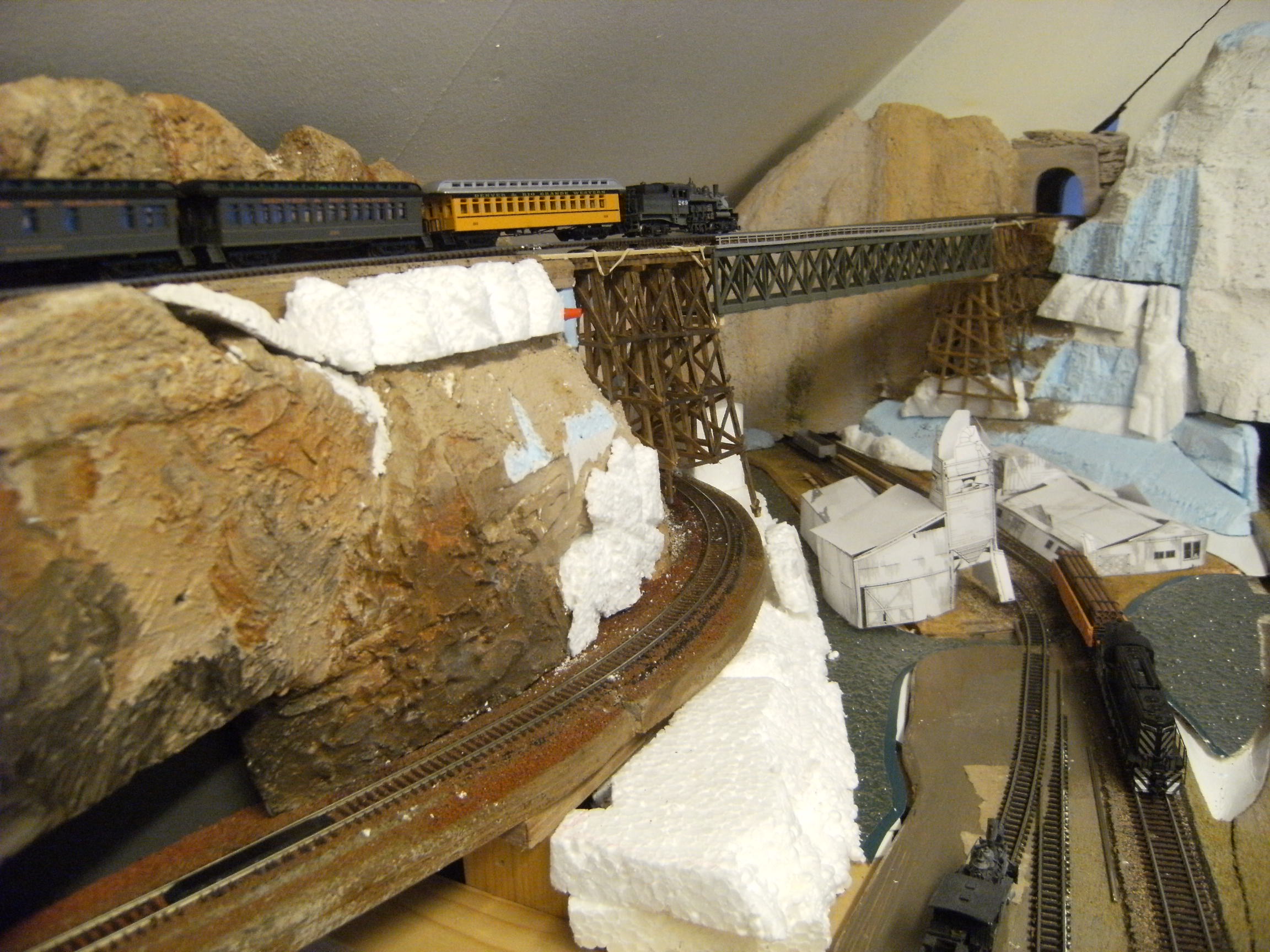
Wyman’s sawmill
During 2 rainy days in my summer vacation I finally built the mill using plans from a 1976 Model Railroader magazine. The location in Rockport had been part of my layout design since more than five years, but the detailed drawings I had studied over and over for the last 40 years contained so much detail that this clearly was not a beginner’s model.
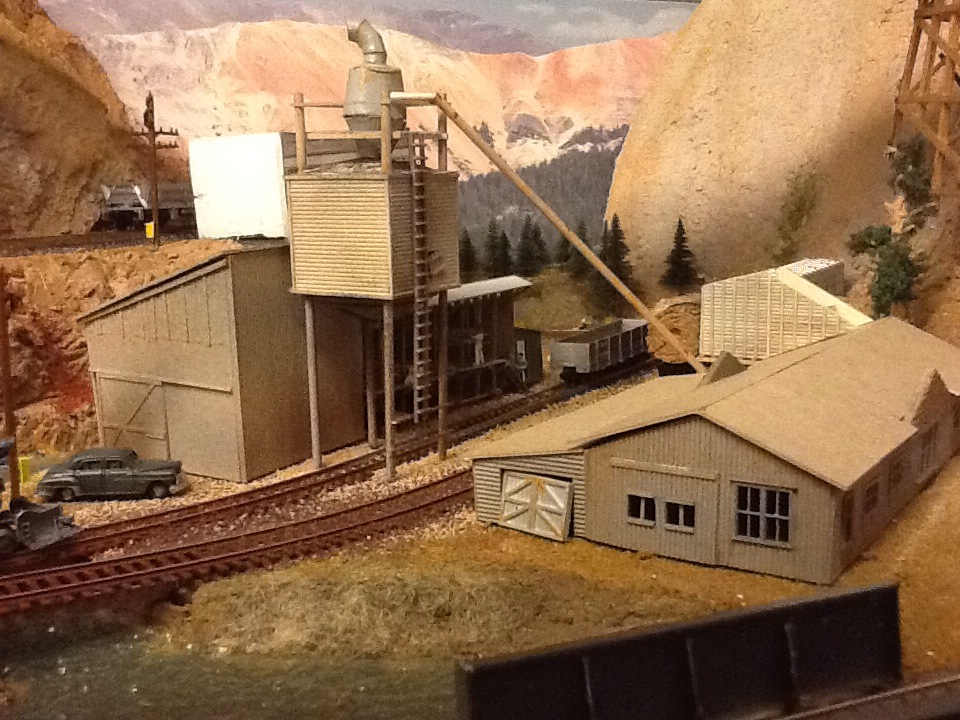
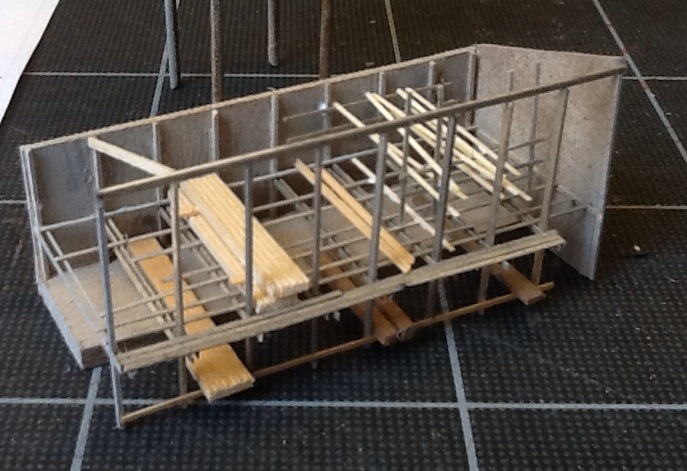
Windows are Grandt Line castings, some adapted by splitting and joining. All doors were hand made from styrene or stripwood. My son suspects me to enter the sawmill in some kind of modelling competition, and perhaps I will some day.
Level 3: Silverton, CO

The final stop on the main line, interchange with SN RR to Ouray and SG&N RR to Gladstone. We were there during a snow storm, so at this point the imagination takes over.
To climb from Rockwood to the High Line, I custom-built a helix in 2012.
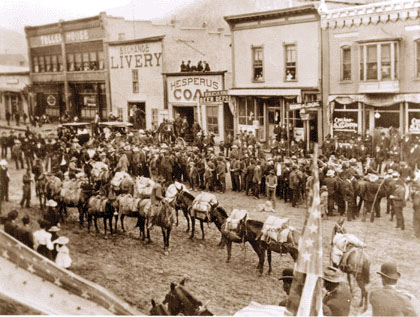
© 2000-2010 The Silverton Magazine (now offline)
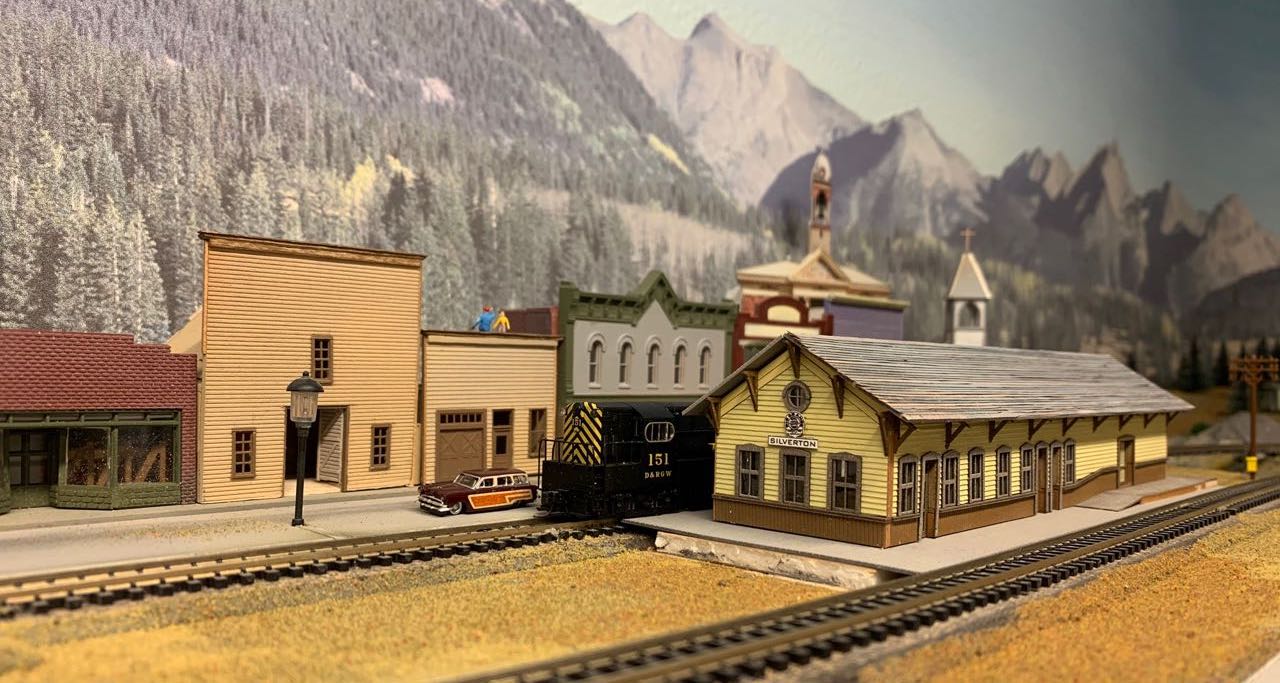
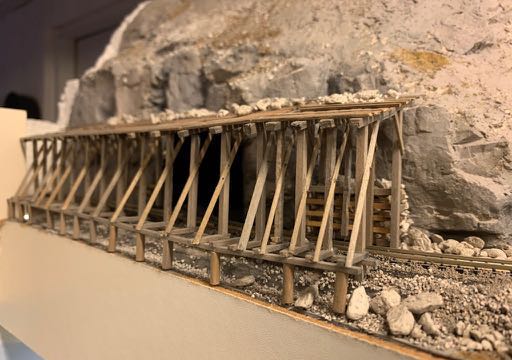
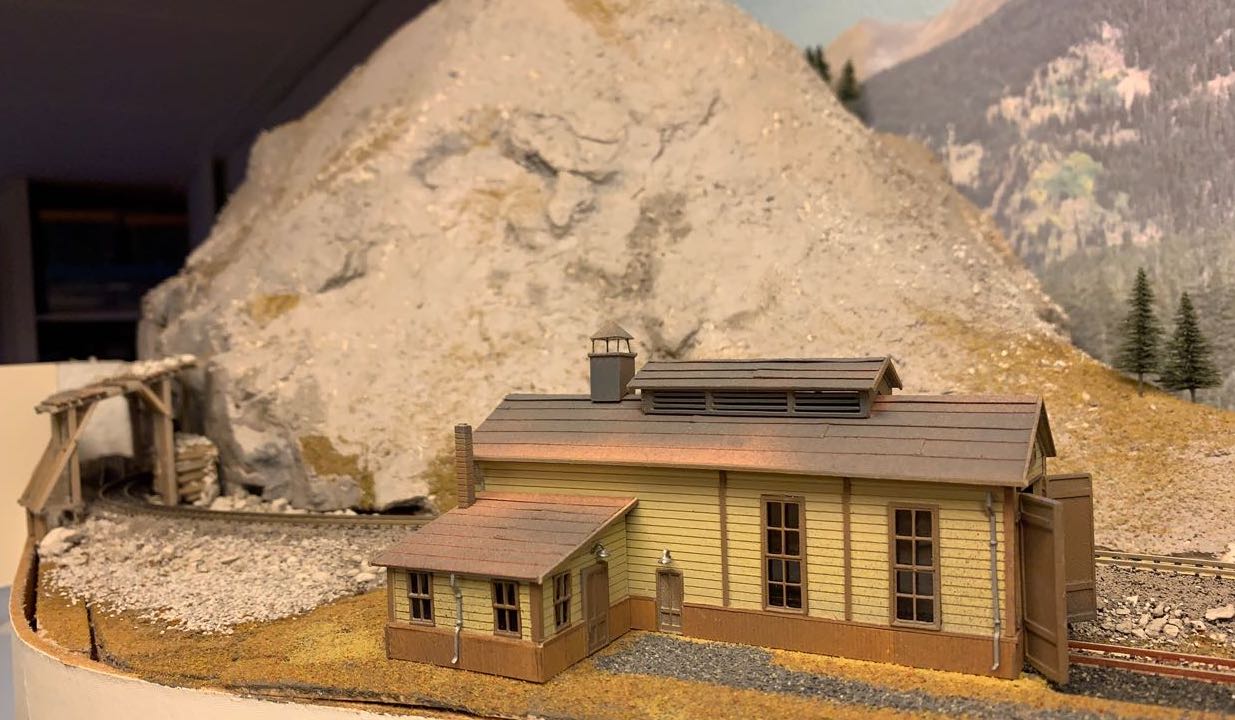
Layout Statistics
Layout Design Analysis, LDA in short, provides insight into how well a model layout will operate given its size, complexity and amount of rolling stock.
LDA was developed by Joe Fugate, but the original web pages are no longer up. Link is to the Wayback Machine, checked Feb 2023.
All credits for LDA go to Joe Fugate.
To summarize the input:
- Room and Layout area are self-explanatory, with the latter representing the total area taken up by just the layout "tabletop" itself.
- Number of turnouts is used to calculate the complexity and operational potential. Count a crossing as a turnout, and count a single slip switch or three-way turnout as 2 turnouts. Count a double slip switch as 3 turnouts.
- Track length is measured as both total footage and as the equivalent number of 40 foot cars (e.g. 4 40' cars per foot in N scale, see table).
- Similarly, measure the actual main line for running trains, and the total of your passing sidings.
- Connecting track = total track - mainline - passing - storage - staging - service
- Staging train length (three values separated by slashes -- longest/average/shortest)
Next, we do some math:
- Max. # of cars = 80% of (storage + staging + passing/2).
- # of cars moved = 40% of (staging x 2 + passing + connecting)
- # of trains = number of cars moved / min(average passing train length, average staging train length)
- Dispatching threshold = (3 x shortest passing siding + 2 x average passing siding + the longest passing siding) / 6
LDA Results:
- Room Area (sq ft)
- 110
- Layout Area (sq ft)
- 86 (78%)
- Number Turnouts
- 61
- Total Track
- 200 ft = 800 cars
- Train Length (max/average/min)
- 18/15/12 cars
- Maximum Number of Cars
- 172
- Number of Trains
- 9
- Dispatching threshold
- 14 car trains
It works nicely with JMRI Operations (Dec. 2012)
Rolling stock
Check out my Rolling Stock Collection.
In January 2007 I entered all my items in a dedicated database Mac-MoVe. It was astonishing to get a good look at all the beautiful items one has collected (and paid for) over the years.
All Items were later added to JMRI Operations Car Roster.
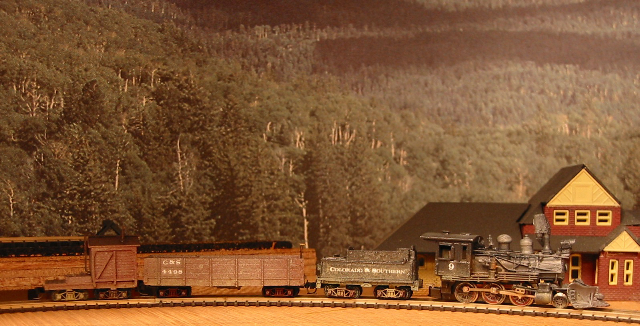
Model RR Links
- N Scale Supply
- A fine shop shipping internationally
- Model Railroader monthly magazine
- The magazine that got me interested in 1974
- NMRA Special Interest Groups (SIGs)
- Thematic groups of interest:
- Layout Design SIG
- they publish the Layout Design SIG Primer
- Operations SIG
- Learn about industries and yard ops
- RailPictures.Net
- Browse large archives of prototype pictures from home

